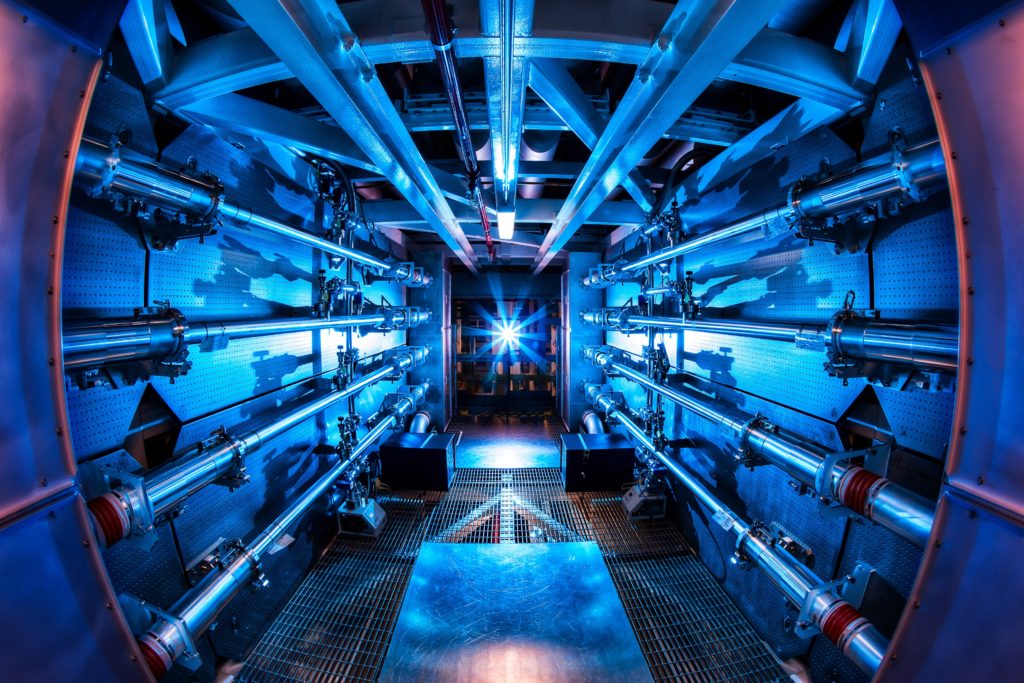There is an adage in the scientific community that fusion power has been within 20 years of viability for about the past 40 years: the technology has proven to be much more difficult to master than previously thought. However, should we be able to master fusion, the possibilities for our future energy needs really becomes compelling. A few methods currently under investigation for fusion power are seeing good developments, however, most are still trying to achieve engineering feasibility. Below is a graph showing all current different types of fusion technologies: this article will focus on the most prominent in modern scientific circles.
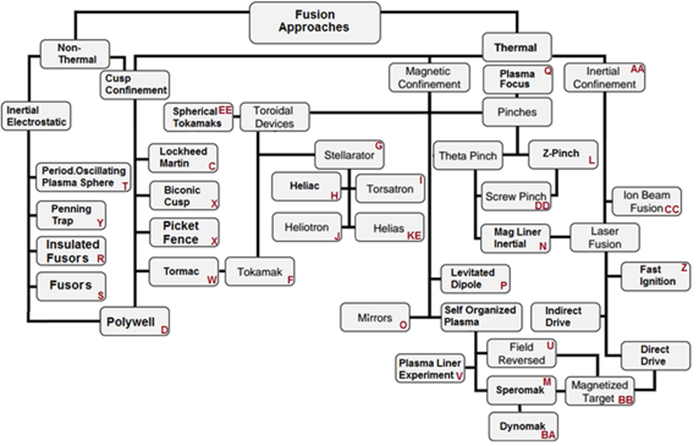
Thermal confinement
Thermal confinement fusion uses heat or large lasers to heat a small fuel pellet many millions of degrees. One of the most common is laser confinement, where the outer shell of the fuel “ignites” causing the inner pellet to explode (this happens very quickly, causing a considerable shockwave). As the inner pellet implodes, large density (several times the density of lead) and temperature (100 million Kelvin) is achieved. This inner pellet then ignites, releasing energy and burning the rest of the fuel pellet. The goal is to achieve a net energy release from the pellet burning compared to the laser energy input. Fusion has been demonstrated by such devices, though a Q value greater than 1 has not. The most notable current developments are the National Ignition Facility (NIF) in the USA and the Laser Mégajoule (LMJ) in France. There are a few leading technologies available in thermal confinement:
- Laser-driven
- Z-pinch
- Acoustic confinement
- Electrostatic confinement
Magnetic confinement fusion
Magnetic confinement fusion uses the magnetic properties of plasma (a mix of positive ions and negative electrons) to keep a dense (~ 1 bar), hot plasma (~ 300 million Kelvin) confined in a chamber to fuse the ions together. There are a few main methods of magnetic confinement fusion:
- Tokamak
- Stellarator
The Tokamak design was originally proposed in 1950 by Andrei Sakharov and Igor Tamm, the first such device being built in Moscow in 1956 at the Institute of Nuclear Fusion. This is the most sought-after device because, in 1968, Q values several degrees in magnitude higher than other devices were achieved.

The Tokamak is a toroid that is rotationally symmetrical. Large helical magnetic fields are produced by running a current through the plasma. This ensures that the plasma is denser in the middle, but also requires considerable external input power. This power can be supplied through re-direction from the power generation on site in a fusion power plant. In areas where the plasma has the lowest interactions with the wall, Berrilium is used as a wall material. While plasma-wall interactions are inevitable, their locations are mostly limited to the areas where magnetic field lines are designed to cross the chamber wall. In these areas, tungsten diverters with a melting temperature of 3695K are placed. Graphite material is used on the walls the area of highest ion flux: Carbon lowers the plasma temperature less than tungsten and retains its shape even after melting.
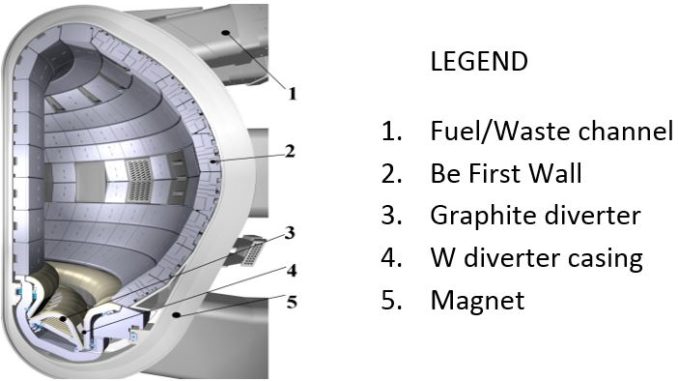
Tokamak designs have inherent flaws. Plasma confinement forces the toroid wall material to be replaced every year. The toroid needs to be large to achieve the required plasma density (larger cross sections increase the plasma magnetic properties, creating a denser plasma core). This increases the wall and waste volume. However, the waste radioactivity is much lower than nuclear applications:
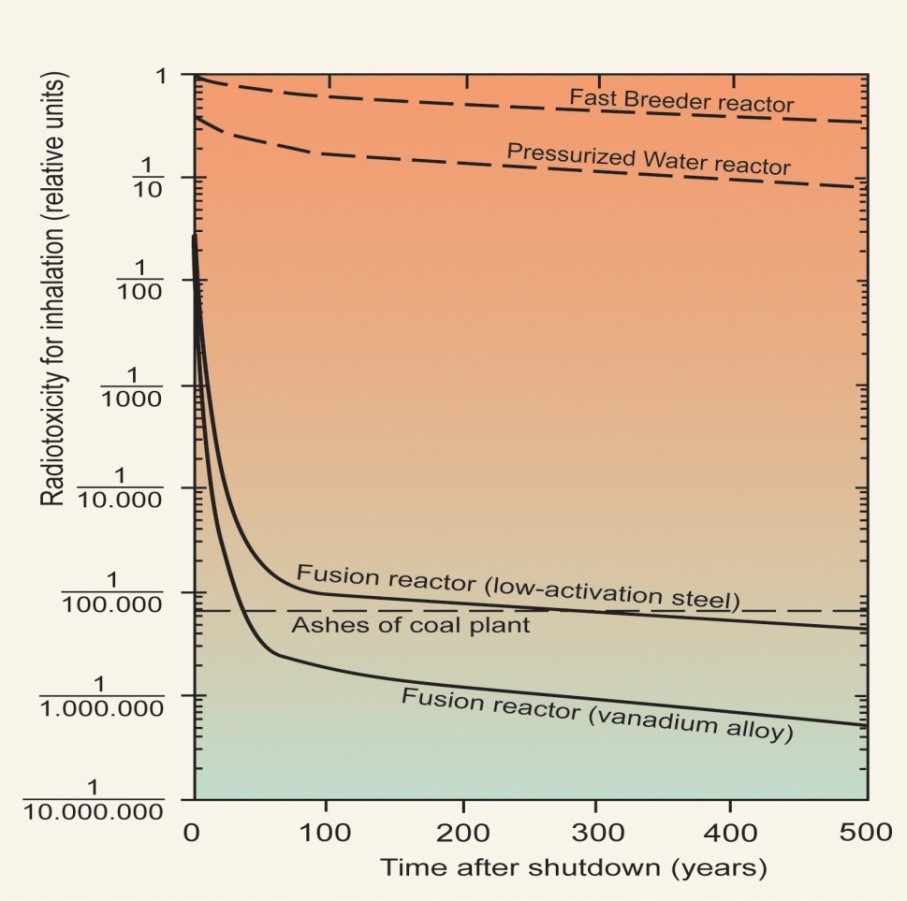
Tokomaks also have their magnetic field lines concentrated in the middle, meaning any larger collisions that do not cause fusion will ultimately cause these ions to hit the wall, an unwanted phenomenon. Up until a few years ago, Tokamaks have been quite successful, and the rate of increase in Tokomak performance had outstripped Moore’s law for the miniaturization of silicon chips.
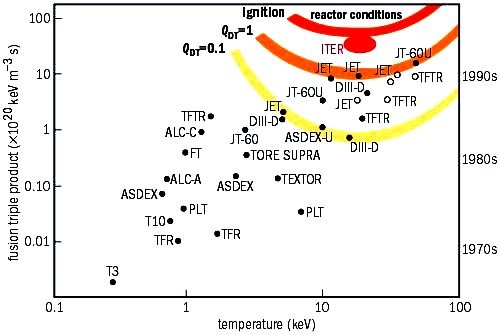
Any given Tokomak device can use a different fuel, and different plasma parameters (within a range). (Q=1) has been successfully achieved at the JT-60U in Japan and the JET in England. The ITER project hopes to achieve plasma ignition, where the fusion reaction will be self-sustaining, and no external input will be required (Q approx. 5).
Wall Materials
The wall materials used in fusion reactors is critical. Wall surfaces face cyclic loading in temperatures higher than 1000 Celsius for sustained periods over years, large neutron fluxes, plasma-wall interactions, and near-vacuum working conditions. As the high-speed plasma particles hit the edge of the wall, some erosion of the wall material occurs. The larger debris particles lower the plasma temperature and inhibit fusion. Fast neutrons present after a fusion reaction can cause the wall material nuclei to change and become radioactive. This is why Beryllium is used for most of the wall: Be is a very light atom and its debris does not lower the plasma temperature significantly, it can efficiently absorb many neutrons safely (having a large neutron cross-section) and has a melting point of 1560K.
ITER
It is hard to mention modern magnetic confinement fusion without reference to ITER. Using its 840m3 reactor chamber, ITER plans to produce 500MW of fusion energy when first plasma is achieved (expected 2025). An expected Q value of 10 is expected to be sustained for up to 400 seconds, allowing for a steady state Q value of more than 5. The project hopes to demonstrate that a plasma can form a self-sustaining ‘burning’ reaction. Other objectives include improving technologies required for fusion power production, expanding tritium breeding concepts, and refining neutron shield/heat conversion technology.
Stellarator
The Stellarator was developed by Lyman Spitzer in 1951; construction started on the first device at the Princeton Plasma Physics Laboratory in 1951. While the Tokamak induces a current to form a magnet, a Stellarator uses external magnetic coils to magnetically confine the plasma. The cross-section of a Stellarator is bent into a figure eight, which solves the problem in Tokomaks where the magnetic field lines are more concentrated in the middle. Notable current Stellarators include the Large Helical Device in Japan, NCSX at Princeton, H-1NF in Australia, and the Wendelstein 7-X in Germany. The figure below shows the plasma in orange, the magnetic coils in blue, and an ion path in black:
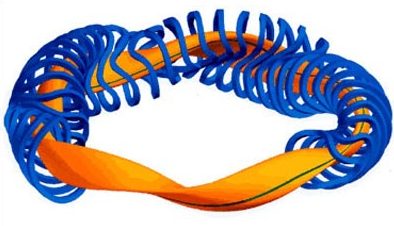
Wendelstein 7-X
The Wendelstein 7-X first conducted plasma heating in 2015, and its team has recently (March 2018) conducted experiments with results published in nature. It is based on the parameters of the Wendelstein 7-AS (pictured above) but is much larger (a plasma volume of 30 cubic meters as opposed to 1 cubic meter). Stellarators suffer from other problems not common in the Tokamak design. Because of the twisting magnetic fields, particle orbits need to be carefully considered to minimize collisional transport and toroidal transport current.
Plasma Heating
To achieve high plasma temperatures, several interesting heating procedures are used. At different fuel temperatures, different methods are used to heat the plasma.
Ohmic Heating
In the initial stages of plasma heating, Joule, or Ohmic heating is used. As current is passed through a resistor, the resistor changes some of the electric energy into heat. Because the plasma is a conductor (a mixture of free ions and electrons), Ohmic heating is considerably effective in heating the plasma. However, the resistivity of plasma decreases in accordance with Spitzer’s law:
![]()
Where: Z – Plasma resistivity, k – plasma-constituent constant, T – Temperature [Kelvin]. This method is most effective for cooler plasma; as the plasma is heated, other methods are used.
Neutral Beam Injection
Another form of plasma heating involves injecting a beam of neutral atoms, typically deuterium (a hydrogen atom with one neutron). The high kinetic energy of these atoms is transformed into thermal energy as the new deuterium bounces off ions in the plasma. Although not originally plasma, the deuterium gets ionized quickly and adds to the background plasma already in the reactor. The atoms must be neutral in order to pass through the magnetic field surrounding the plasma; once in the plasma, the ions are charged via collisions, to stay confined within the plasma and transfer their energy to the plasma. The attenuation of a neutral beam is governed by the following equation:
![]()
Where: IB(s) – the flux of neutral particles [particles/m2s], n – plasma ion / electron density [particles/m3], <σv> – activity for charge-exchange ionization [m3/sec], and λ is the mean free path for the attenuation [m]. Experiments reveal that plasma will be heated if the mean free path is greater than one fourth the plasma radius. Therefore, the neutral beam energy required can be calculated:

For typical applications this is 50 keV to 130 keV, depending on plasma density. In comparison, the central plasma region has a maximum thermal energy of 15 keV.
Other forms of heating
Other forms of heating include radio-frequency heating, where the plasma caused to move to the motion of an electrostatic wave. This macro movement causes plasma heating. A subset of this heating is wave heating. Fusion alpha-heating is also used; however, this uses high energy fusion by-products (Helium) to heat the plasma.
Economics
The capital and operational costs of fusion power generators strongly depend on the technology used and the fuel (fusion reaction) chosen; good comparisons can be drawn with natural gas and nuclear power reactors. The general trend for nuclear power plants is for a greater O/M cost and smaller fuel cost as the plant ages. Regulatory delays, redesign requirements and difficulties in construction management and quality control all inflate costs. Fusion Tokamaks and Stellarators are calculated to have higher capital costs than nuclear stations; a report entitled “Power Plant Conceptual Study (PPCS)” written by the EFDA in 2005 analyzed 4 different Tokomak models both economically and environmentally. The sizes of these reactors are shown in figure 8, ITER is shown as a comparison.
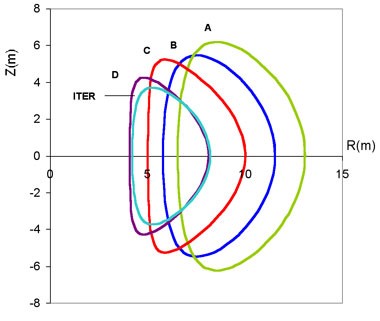
The study found that the economic feasibility of fusion reactors highly depends on the downtime of the reactor. Because wall materials need to be replaced, a replacement scheme needs to be implemented that can maximize the reactor availability for power production. Using the most optimized geometries, a reactor availability of over 75% can be achieved – enough for economic feasibility.
It should be noted that such a study in conceptual; most studies like this tend to lower the foreseeable costs, as this is the agenda of the parties involved
Environmental Impact
The environmental impact of fusion reactors is highly dependent on their application and fuel cycle. As shown in table 1, the D-T reaction creates the highest energy neutrons. High energy neutrons travel the longest before losing their energy and cause the most disruptions. Using Tritium (which is radioactive with a half-life of 12.4 years) also increases the radioactivity of the cycle. Because of the high neutron flux inside a D-T plasma and immediate wall, the reactor can be used as a breeder reactor for nuclear applications. This will increase the radioactivity inside the reactor, and its time before the reactor metals can be reused. In the case were no breeding is done (neutrons are moderated conventionally), half the material used as the first wall would be suitable for re-use within 100 years if the D-T reaction were used. Also, the rate of decay is considerably different for different wall materials used, as shown in figure9.
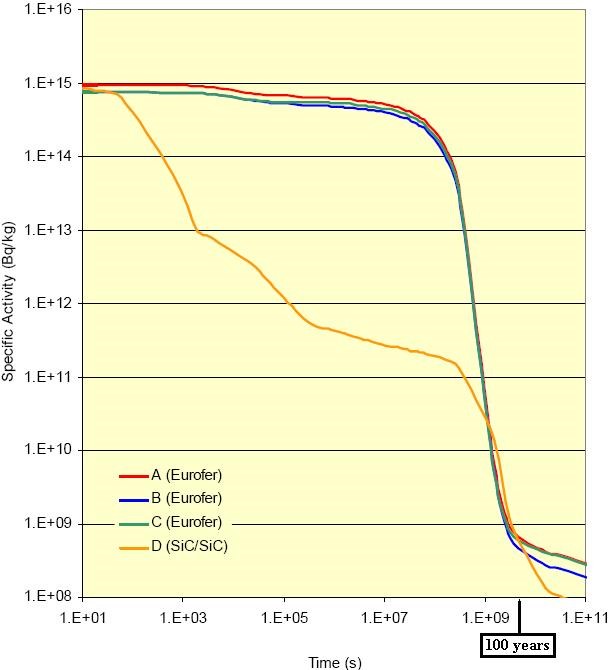
It is evident that ferrous alloys will be more radioactive during the decay cycle than carbon-silicon alloys.
Waste
In the PPCS, the waste production for option A, the biggest option, are classifications are as follows:

The waste volume is shown in figure 9. It should be noted that there is no high-level waste after 100 years. After 150 years, all waste will be classified as either SRM or NAW.
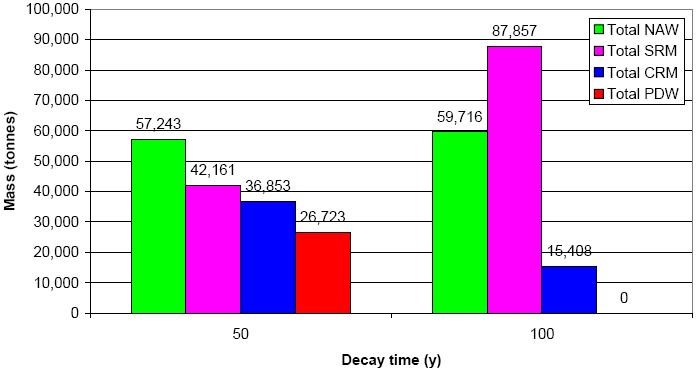
Accidents
Fusion reactors have an intrinsic safety feature for accidents. Because only about 30 minutes of fuel is present in the reactor at any given time (compared to a year’s worth in nuclear reactors), the implications of a nuclear complete catastrophe are many magnitudes smaller than a nuclear catastrophe. As studied in the PPCS, the worst case most exposed individual 7-day dose for the largest plant option A for the Loss of coolant flow inside the reactor and loss of coolant outside the reactor is 0.42 mSv. An X-Ray scan gives 0.04-1.0 mSv, depending on the size of the scan.
However, a catastrophe will cause wall material to rise to unacceptable temperatures. The economic implications of an accident, as studied in the PPCS, are known as external costs. The external costs of option A were found to be 0.861 million Euro/kWh, with a 68% confidence in the (0.225 – 3.494) range. The size of this range indicates this is an inexact science; exact values cannot be estimated accurately.
Conclusion
While nuclear reactors are not within the immediate future for use as an energy source, their study is greatly beneficial to the scientific community. Before reaching economic feasibility, magnetic confinement fusion reactors still need considerable research and development. Tokamak reactors are currently the most promising. However, these reactors are still decades away from economic feasibility. Even if we never use fusion energy for commercial purposes in the next 100 years, it can prove to be a compelling source of energy in the long term for the human race.
